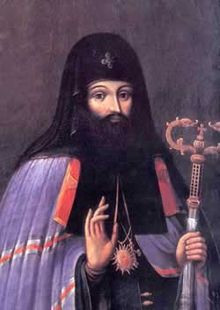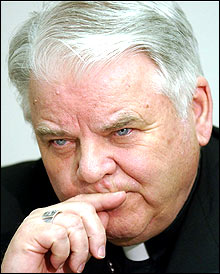MP: I am an Orthodox layman from London educated at Oxford. I wrote my
doctorate on the Macarian writings under the supervision of Metropolitan
Kallistos Ware. Since 2000 I have been at the Institute for Orthodox Christian
Studies in Cambridge, latterly as Academic Director.
AD:
What led you to write this book in particular?
MP: It
was a book I felt had to be written - not only because it was a vastly
important subject area that hadn't been tackled before, but also as an attempt
to dispel some of the negative and oppositional (i.e. anti-Western) accounts of
Orthodoxy that have tended to prevail in recent years. Such accounts, to my
mind, are not properly faithful to Orthodox tradition and tend to undermine
Orthodox witness in the world today. The fact that so many Orthodox saints and
scholars over the centuries have admired and made good critical use of Aquinas
warns us that any blanket rejection of him and all he stands for is a
relatively recent development within Orthodoxy.
AD: Tell us a little bit about your method of 'reverse perspective' or 'multiple
perspectives' and how that helped in writing this book.
MP:
As you appreciate, this method came through thinking about the artistic
principles of the Orthodox icon. Approaching the Fathers more as one would an
icon than as a mere object of enquiry helps us to be more receptive and less
hubristic in our approach to the tradition. I have also expanded the principle
of multiple perspectives to underpin some of the more unusual things I do in the
book - e.g. the presentation of a 'Byzantine Aquinas', or Palamas' sympathies
with Latin theology and theological methodology, or the Barlaamite character of
Byzantine anti-Thomism. All this, I hope, will encourage many people to look
with a rather different perspective on some of the supposed certainties of
Orthodox anti-Westernism.
AD:
Your first chapter on Aquinas and the Greek East makes mention several times of
multiple forms of Thomism depending on period, 'school,' etc. Was it a
difficult task trying to sort through all the different expressions of Thomism
extant?
MP: Yes.
AD:
Am I correct in thinking that Palamas seems to be coming in for something of a
re-consideration lately by Orthodox thinkers who realize he has often been put
forth--as you note several times in your book--less for his own merits, and
more as a supposed counterpoint to Aquinas, both almost equally 'mythologized'?
MP: There
are indeed encouraging signs of a sea-change.
AD: The extent of Thomas' appreciation for the East ('Greeks'), which you detail
in your first chapter, was astonishing to me. He really seems much more
generous and gracious than I would have expected. Were you also surprised by
these findings?
MP:
Yes, while I knew of his fascination with Dionysius and admiration for St John
of Damascus, I was stunned by the extent of his engagement with patristic,
conciliar, and Byzantine sources.
AD:
Your next chapter notes a similar openness to the Latin West in Gregory Palamas--more
so than in those who come after him or claim to be his followers or
interpreters. Was that also surprising to you?
Less
so - this is something I knew something of as a graduate student, but even here
I found much more than I had anticipated.
AD: Tell us a bit about the role the Kievan Academy plays, especially under Petro
Mohyla, in shaping East-Slavic understandings and interpretations of Thomism,
scholasticism, and 'the West' generally.
MP:
The Kievan school has some claim to being treated as a species of Occidental
Orthodoxy - i.e. a consciously Western expression of Orthodox tradition. While
not all achievements of that school are equally admirable (or equally
Orthodox), this school cannot be written off as a corruption of Orthodoxy.
 |
| Petro Mohyla |
AD:
What changes in modern Orthodoxy such that its perceptions of, and reactions
to, 'Thomism' and 'scholasticism' almost seem to suggest an allergic reaction
to both, in distinction to the earlier openness and often deep and gracious
consideration you so skillfully document?
MP:
A very good question. I trace much of this allergic reaction back to the
anti-Westernism of the Russian Slavophiles (itself, ironically, conditioned by
German Idealism and Romanticism). Aggressive expansionism on the part of both
Catholicism and Protestantism in the early modern and modern periods will not
have helped matters. But it seems to me that an uncompromising defence of
Orthodoxy has no need for a global rejection of the West and all its works.
Dositheos of Jerusalem is a fine case in point - a fierce defender of Orthodoxy
(known as the 'scourge of the Latins') but deeply sympathetic, in practice, to
Latin theology.
AD: Am I right in seeing your book as part of a larger and long-term project
(in which you and numerous others seem at work today) of reconsidering
Orthodox-Catholic history in order to clear away what we would now regard as
baseless misunderstandings that needlessly divide us?
MP:
This is a fair comment. It seems to me that if if ecumenism has a future, it is
one in which the Churches plunge ever deeper into their respective traditions
rather than seeking some sort of artificial commonality. There remains some
serious differences between Orthodox and Catholics but there is also a great
deal of misunderstanding that can be swept away.
AD:
What projects are you working on currently?
A
project on Wisdom in the Church Fathers that has been on hold while I completed
the project on Aquinas.
AD: Sum up for us what you hopes or expectations you have for this book
I hope some
people will read it!

